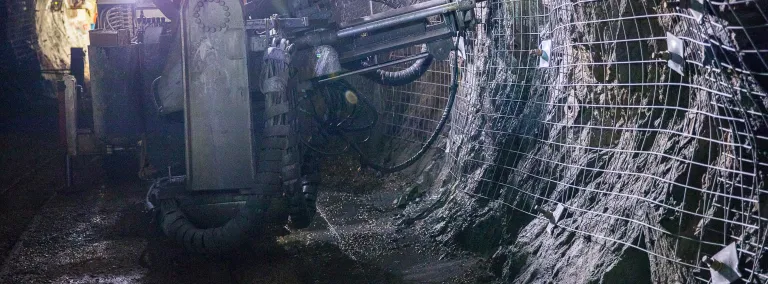West Drift project nears completion
After installing thousands of bolts, a half-mile of mesh and pipe supports, Mike Oates sees a light at the end of the tunnel
After three years of drilling, bolting and installing pipe supports in the West Lab Access Drift on the 4850 Level, Mike Oates sees the light at the end of the tunnel.
“It’s 2,600 feet from the Yates station to Governor’s Corner and I’ve been up and down it three times,” said Oates, an infrastructure technician with Sanford Lab’s Underground Maintenance Crew. “It feels like I’ve been working on this forever. But we’re almost done and it feels good.”
Oates installed thousands of bolts and a half-mile of welded wire mesh—on first one side of the drift, then on the other. The project is expected to be completed in November.
The drift is the main pathway between the Yates and Ross campuses and traffic will only increase as construction on the Long-Baseline Neutrino Facility and Deep Underground Neutrino Experiment (LBNF/DUNE) project gets underway, said Mike Headley, executive director for the South Dakota Science and Technology Authority and lab director for the Sanford Underground Research Facility.
“As the secondary egress for the Davis Campus, the West Drift is incredibly important to provide safe access for our staff, researchers and partners,” Headley said. “Now, with the fresh ground support, we know the drift will be safe as we move forward with the LBNF/DUNE project.”
Since re-entry into the facility in 2009, Oates worked on various projects, including shaft maintenance, removing the tank that once held Ray Davis’ Nobel-Prize winning research and spot bolting. Oates even helped build the Davis Campus. But work on the West Drift began in earnest in 2014 with the arrival of the Fletcher bolter.
“The bolter worked as designed and allowed Mike to safely install ground support at heights taller than the other typical drifts in our facility,” said Bryce Pietzyk, underground access director.
“Mike has done an excellent job on this project,” Pietzyk continued. “He has accomplished installing the ground support while also providing safe egress through his work area. Mike takes great pride in his work.”
And that’s not surprising. Oates worked as a miner for Homestake for 21 years. When the mine closed in 2002, he went to work at Stillwater in Montana, a palladium and platinum mine. He returned to the area in 2006 to help prepare the facility for re-entry.
“Mining is in my blood. It’s challenging and I’ve always enjoyed it,” Oates said. But he also enjoys talking to people who pass through the drift on their way to and from the Ross Campus.
“It’s different now. I’m working to support science, to make things safe for science. I’ve gotten to know some of the scientists better. I even know more about physics now,” he said, laughing.
